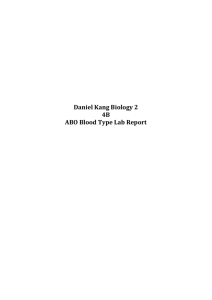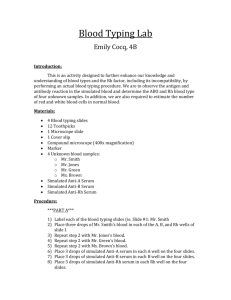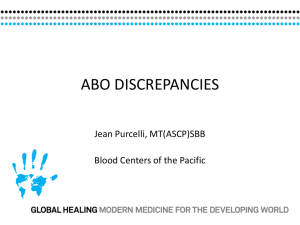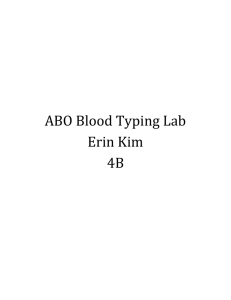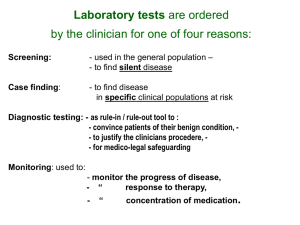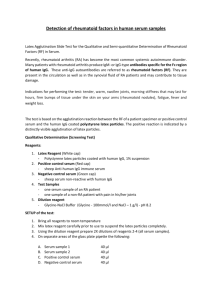Blood lab
advertisement
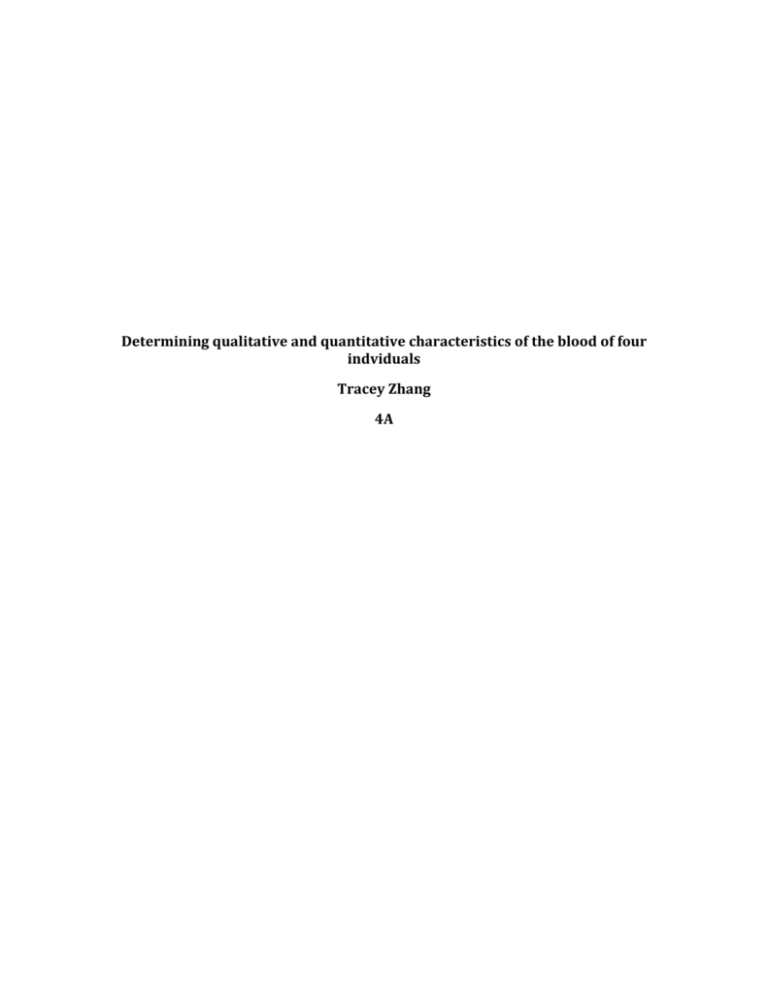
Determining qualitative and quantitative characteristics of the blood of four indviduals Tracey Zhang 4A Blood Lab Purpose The genotype of a person’s blood determines many characteristics that affect a person’s life. This includes the blood type (A, B, or O) and whether it is marked with the Rh factor (the presence of the chemical means the blood is positive, the absence means it is negative). A blood type’s significance is that it indicates what types of blood cannot be transfused into the person’s blood (blood type A cannot mix with blood type B) because when an incompatible blood type enters a person’s body, the person’s blood has antibodies that attack the “invading” blood. The presence of A, B, or O chemical markers indicate the antigen and the presence/lack of Rh chemical marker indicates whether the blood is positive or negative. Therefore, the purpose of part A of the lab is to determine the blood types of four people, Mr. Smith, Mr. Jones, Mr. Green, and Ms Brown. In part B of the lab, the purpose is to find the number of red and white blood cells per cubic millimeter of an unknown sample of blood. Materials To complete the lab’s purpose, two experiments (one for part A and one for part B) will be set up. The experiment for part A first involves taking a sample of each of the four people’s blood (simulated) and mixing it with anti-A serum, anti-B serum, and anti-Rh serum. The second part of the experiment (part B) involves taking an unknown sample of simulated blood and using a microscope to find the number of red/white blood cells per square millimeter. This requires materials to complete. Blood typing slides (4x) Toothpicks (12x) Microscope Slide (1x) Cover slip (1x) Compound Microscope (magnification of 400x) Marker Unknown blood samples (4x; Mr. Smith, Mr. Jones, Mr. Green, Ms Brown) Simulated Anti-A Serum Simulated Anti-B Serum Simulated Anti-Rh Serum Procedure Using the materials above, part A and part B of the experiment both need to be successfully completed. The first part (part A) involves placing all four samples of blood into the blood typing slides and placing anti-A serum, anti-B serum, and antiRh serum in one of the three wells on each slide. If a chemical reaction occurs, then the blood is reacting to the serum, meaning that the A, B, or Rh chemical marker is present. This method would determine the different blood types that the four people have. Part B involves using a compound light microscope and counting the red blood cells and the white blood cells in an unknown sample of blood and using calculations to determine the number of red/white blood cells per cubic millimeter. More detailed procedures are located below. Part A: 1. Label each blood typing slide (Slide #1: Mr. Smith, Slide #2: Mr. Jones, Slide #3: Mr. Green, Slide #4: Ms Brown) 2. Place three drops of Mr. Smith’s blood in each of the A, B, and Rh wells of Slide #1. 3. Repeat step #2 with the three other blood samples (Mr. Jones, Mr. Green, and Ms Brown) with each of the respective slides (Slide #2, Slide #3, and Slide #4). 4. Place three drops of Anti-A Serum in each A well on the four slides. 5. Place three drops of Anti-B Serum in each B well on the four slides. 6. Place three drops of Anti-Rh Serum in each Rh well on the four slides. 7. Using three toothpicks per slide (12 toothpicks total), stir each well with a separate, clean toothpick for thirty seconds. 8. Observe each slide and record any observations. Part B: 1. Thoroughly shake one vial of WARD’s Simulated Blood. 2. Add one drop of simulated blood to a microscope slide and cover with a cover slip. 3. Examine the slide on low power (100x) and find an area with an even distribution of cells. 4. Switch to high power (400x), refocus, and count the number of simulated red blood cells in the grid box. Record these results. 5. Count the number of simulated white blood cells in the grid box. Record these results. 6. Repeat the counting procedure twice in steps 4 and 5 on two different grid boxes. Record these results. 7. Calculate the average of the three red blood cell counts and the average of the three white blood cell counts. Record these results. 8. Multiply the average of the three red blood cell counts by the dilution factor and the average of the three white blood cell counts by the dilution factor to find the number of red and white blood cells per cubic millimeter. Record the results. Conducting the Experiment: The below pictures show the different steps and help better understand the process. The first section illustrates part A of the experiment, which involves mixing samples of blood and the anti-A/B/Rh serums. The first picture shows the samples of blood before mixing with the serums and the second picture shows the blood after being mixed. The next set of picture demonstrates part B of the lab. The first picture shows my partner using a compound light microscope while the second picture shows the slide used. Part A: Figure 1 shows the four simulated blood types in blood-typing slides and labeled with each person's name before being mixed with serums. Figure 2 shows the results of mixing the simulated blood types and the serums. A reaction means that the chemical indicator is present (if the blood reacts to anti-A serum, then the blood has the A chemical marker on it). Part B: Figure 3 shows the compound light microscope used to conduct the experiment. The microscope contains levels of magnification from 10x to 400x. For this experiment, 400x was primarily used, Figure 4 shows the microscope slide used in the experiment. It contains a grid, with the number of red/white blood cells coming from one grid box. Raw Data: Part A: Results of a mixture of four unknown types of blood and antiA/B/Rh serums Anti-A Serum Anti-B Serum Anti-Rh Serum Slide #1 (Smith) Slide #2 (Jones) Slide #3 (Green) Slide #4 (Brown) Reaction No reaction Reaction No reaction Reaction No reaction Reaction No reaction Reaction No reaction No reaction No reaction Figure 5 shows the results of the experiment conducted in part A, which determined each individual's blood type. Part B: Mr. Green’s blood Number of cells in an unknown sample of blood Blood Cell Type Cell Count 1 Red 207 White 7 2 324 9 3 314 6 Figure 6 shows the number of red and white blood cells counted in three grid boxes from Mr. Green's blood. Processed data: This data includes the conclusions drawn from the raw data collection that helps complete the purpose of this lab. In part A, a reaction from any of the mixtures of simulated blood and serum means that the chemical indicator is present in the blood (ex. if the mixture of blood and anti-A serum begins to turn solid, then the blood has the A chemical marker). Reactions (or lack of reactions) between the simulated blood and anti-A/B serums determine whether the blood is type A, B, or O. A reaction between the simulated blood and anti-Rh serum indicates whether the blood is positive or negative. In part B, each of the red and white blood cell counts, shown in Figure 6 is used to find the number of red/white blood cells per cubic millimeter. This is done by taking the average of the red/white blood cells (281.67 and 7.33) and multiplying it by the dilution factor (150,000 and 5,000). Part A: Results of a mixture of four unknown types of blood and anti-A/B/Rh serums and the blood type it indicates Anti-A Serum Anti-B Serum Anti-Rh Serum Blood Type Slide #1 Reaction No reaction Reaction Type A (Smith) (Type A) (Positive) Positive Slide #2 No reaction Reaction No reaction Type B (Jones) (Type B) Negative Slide #3 Reaction No reaction Reaction Type A (Green) (Type A) (Positive) Positive Slide #4 No reaction No reaction No reaction Type O (Brown) Negative Figure 7 shows the type of blood each person has based on the data indicating the blood's reaction to each of the serums. Part B: Number of cells per cubic millimeter in an unknown sample of blood based on Figure 5 Blood Cell Count Total Average Dilution Total Number of Cell Number number of Factor blood cells per 1 2 3 Type of Cells cells or mm^3 or average Total of number of cells x Three dilution factor Red 207 324 314 845 281.67 150,000 42250500 White 7 9 6 22 7.33 5,000 36650 Figure 8 shows the total number of red and white blood cells in a cubic millimeter. This was found by taking the average number of cells from three grid boxes and multiplying it by the dilution factor. Calculation: Average of red blood cells: (207 + 324 + 314)/3 = 281.67 Total number of red blood cells per mm^3 = average number of red blood cells x dilution factor = 281.67 x 150,000 = 42250500 Discussion: Part A: From the results shown in Figure 5, it can be determined that Mr. Smith has type A positive blood, Mr. Jones has type B negative, Mr. Green has type A positive, and Ms Brown has type O negative. First, Mr. Smith’s blood was placed on a blood-typing slide, with the anti-A serum and the anti-Rh serum causing the blood to begin sticking together. This indicates the blood is reacting to the serum, meaning that the chemical markers (A and Rh) are present in the blood. This occurs because when the anti-A/Rh serum enters the bloodstream, the antibodies detect the invaders and kill it. If the antigen (A, B, or O) is not present, then no reaction occurs because the antibodies do not detect them. The same setup was used for Mr. Jones’s blood. As shown in Figure 5, his blood reacted to only the anti-B serum, meaning that he has Type B negative blood. For Mr. Green, his blood reacted to the anti-A serum and anti-Rh serum. This indicates that h e has type A positive blood. Finally, Ms Brown’s blood reacted to none of the serums, meaning that she has type O negative blood. Her blood type also shows that she is a universal donor, because her blood type would not cause a reaction when transfused with any blood type. Part B: In part B of the experiment, the number of red blood cells and white blood cells were counted in three grid boxes using a sample of Mr. Green’s blood. First, using a compound light microscope, the number of red blood cells and white blood cells in three grid boxes were counted. The averages of these three blood cell counts were then calculated and the number per cubic millimeter was found by multiplying by the dilution factor. Based on the number of red blood cells counted in the three grid cells, the average is 281.67 and the number per square millimeter is 42250500. Based on the number of white blood cells counted in the three grid cells, the average is 7.33 and the number per square millimeter is 36650. From these numbers, it can be seen that the number of white blood cells is much less than the number of red blood cells (figure 8). Thus, the dilution factor for red blood cells is higher than the dilution factor for white blood cells. Conclusion: Overall, the experiment determined the blood types of the four individuals and the number of red and white blood cells in an unknown sample of blood; this also determined the dilution factor. The experiment went well for the most part because my group members and I followed instructions and did not have many problems. However, the data in figures 6 and 8 are not completely accurate because of the method used to gather it. To find the number of red and white blood cells, my partner and I counted the number through the compound light microscope. It is highly improbable that the numbers are exact but should be near the correct number. If I could redo this lab, I would use a more accurate way of counting the number of blood cells in a grid box and be more careful when mixing the blood and serum so that it does not splash. If I could improve the experiment, I would investigate the possible genotypes if offspring were created and determine if Rh incompatibility issues exist.

